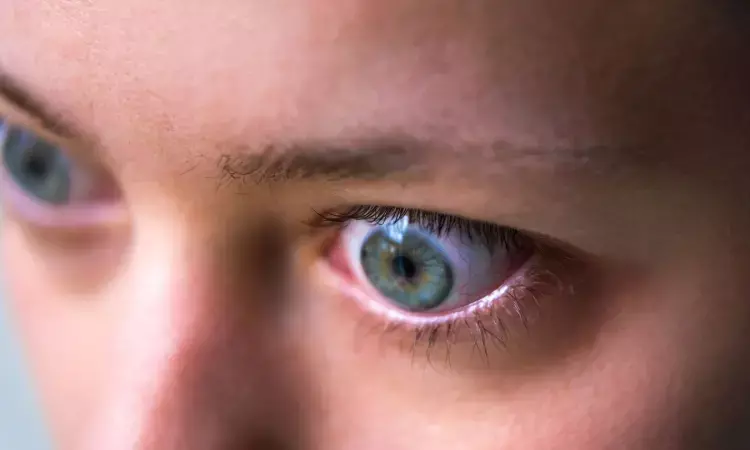- Home
- Medical news & Guidelines
- Anesthesiology
- Cardiology and CTVS
- Critical Care
- Dentistry
- Dermatology
- Diabetes and Endocrinology
- ENT
- Gastroenterology
- Medicine
- Nephrology
- Neurology
- Obstretics-Gynaecology
- Oncology
- Ophthalmology
- Orthopaedics
- Pediatrics-Neonatology
- Psychiatry
- Pulmonology
- Radiology
- Surgery
- Urology
- Laboratory Medicine
- Diet
- Nursing
- Paramedical
- Physiotherapy
- Health news
- Fact Check
- Bone Health Fact Check
- Brain Health Fact Check
- Cancer Related Fact Check
- Child Care Fact Check
- Dental and oral health fact check
- Diabetes and metabolic health fact check
- Diet and Nutrition Fact Check
- Eye and ENT Care Fact Check
- Fitness fact check
- Gut health fact check
- Heart health fact check
- Kidney health fact check
- Medical education fact check
- Men's health fact check
- Respiratory fact check
- Skin and hair care fact check
- Vaccine and Immunization fact check
- Women's health fact check
- AYUSH
- State News
- Andaman and Nicobar Islands
- Andhra Pradesh
- Arunachal Pradesh
- Assam
- Bihar
- Chandigarh
- Chattisgarh
- Dadra and Nagar Haveli
- Daman and Diu
- Delhi
- Goa
- Gujarat
- Haryana
- Himachal Pradesh
- Jammu & Kashmir
- Jharkhand
- Karnataka
- Kerala
- Ladakh
- Lakshadweep
- Madhya Pradesh
- Maharashtra
- Manipur
- Meghalaya
- Mizoram
- Nagaland
- Odisha
- Puducherry
- Punjab
- Rajasthan
- Sikkim
- Tamil Nadu
- Telangana
- Tripura
- Uttar Pradesh
- Uttrakhand
- West Bengal
- Medical Education
- Industry
Facial Photograph-Based AI Tool Promising in Thyroid Eye Disease Assessment: Study Shows

South Korea: A recent study published in Ophthalmology Science has found that a deep learning (DL)-driven method for measuring proptosis in thyroid eye disease (TED) patients using standard facial photographs has shown promising accuracy, potentially transforming traditional exophthalmometry practices.
The AI model demonstrated a mean absolute error of just 1.27 mm, strongly correlated with conventional measurements (r = 0.82), and achieved a high diagnostic accuracy (AUC: 0.91). It accurately identified significant proptosis changes (≥2 mm) in 74.6% of cases, highlighting its potential as a reliable, non-invasive tool for clinical use.
Proptosis, a common feature of thyroid eye disease, causes forward bulging of the eyeball due to tissue expansion within the orbit. It can impair vision, cause discomfort, and affect appearance—impacting patients’ quality of life. While tools like the Hertel exophthalmometer remain the gold standard for measuring proptosis, they require training and equipment. To address this, Jae Hoon Moon, Center for Artificial Intelligence in Healthcare, Seoul National University Bundang Hospital, Seongnam, Republic of Korea, and colleagues aimed to develop and evaluate a deep learning-based system to measure proptosis from facial photographs, offering a simpler, non-invasive alternative.
For this purpose, the researchers conducted a retrospective cohort study involving 1,108 TED patients from Severance Hospital and 171 from Seoul National University Bundang Hospital. They developed a deep learning-assisted system trained on 1,610 facial images paired with Hertel exophthalmometry values and validated it using 511 external images. The model, based on a dual-stream ResNet-18 neural network, used both RGB images and depth maps from the ZoeDepth algorithm. Its performance was evaluated using MAE, Pearson’s r, ICC, and AUC.
Based on the study, the researchers reported the following findings:
- The deep learning-assisted system achieved a mean absolute error (MAE) of 1.27 mm on the Severance Hospital (SH) dataset and 1.24 mm on the Seoul National University Bundang Hospital (SNUBH) dataset.
- Pearson correlation coefficients were 0.82 for SH and 0.77 for SNUBH, indicating strong agreement with clinical measurements.
- Intraclass Correlation Coefficients (ICCs) were 0.80 for SH and 0.73 for SNUBH, reflecting high reliability.
- The area under the ROC curve (AUC) for detecting proptosis was 0.91 for SH and 0.88 for SNUBH.
- The system detected significant proptosis changes (≥2 mm) with an accuracy of 74.6%.
The study introduced a deep learning-assisted system that accurately measures proptosis in patients with thyroid eye disease using simple facial photographs. This accessible and user-friendly tool presents a promising alternative to traditional exophthalmometry, expanding access to reliable measurements even in non-specialist or resource-limited settings.
"While further validation across diverse populations is needed, the system has the potential to enhance TED severity assessment, monitor disease progression, and evaluate treatment response, with future applications possibly extending beyond TED," the authors concluded.
Reference:
Park, J., Yoon, J. S., Kim, N., Shin, K., Park, H. Y., Kim, J., Park, J., Moon, J. H., & Ko, J. (2025). Deep Learning-Driven Exophthalmometry Through Facial Photographs in Thyroid Eye Disease. Ophthalmology Science, 100791. https://doi.org/10.1016/j.xops.2025.100791
Dr Kamal Kant Kohli-MBBS, DTCD- a chest specialist with more than 30 years of practice and a flair for writing clinical articles, Dr Kamal Kant Kohli joined Medical Dialogues as a Chief Editor of Medical News. Besides writing articles, as an editor, he proofreads and verifies all the medical content published on Medical Dialogues including those coming from journals, studies,medical conferences,guidelines etc. Email: drkohli@medicaldialogues.in. Contact no. 011-43720751


